
The Madras High Court noted the absence of a standardized procedure for handling the remains of pregnancies terminated in minor girls. The court emphasized the need for statewide guidelines to address this issue.
- The entire product of conception is transferred to the Forensic Science Laboratory for analysis in cases of pregnancy termination up to 24 weeks. Conversely, for pregnancies terminated beyond 24 weeks, only the femur is sent to the Forensic lab, while the remaining components are categorized as biomedical waste and disposed of accordingly.
- The Forensic Science Laboratory is uniquely equipped with specialized facilities capable of preserving pregnancy remains. Unlike hospitals, police stations, and courts, the forensics lab possesses the necessary infrastructure to maintain these specimens in a condition suitable for potential future forensic analysis.
- Currently, there are no established protocols for handling the remains from pregnancy terminations. The inconsistent practices include handing these remains over to the court, which then transfers them to the police, who ultimately deliver them to the victim’s family. Due to this lack of uniformity and potential mishandling, the court has been requested to establish clear guidelines for managing these sensitive materials.
- Obtaining a report from the Forensic Science Laboratory can take at least a month, and often requires several months. During this extended period, the pregnancy remains are preserved at the Forensic Lab. The primary challenge arises upon completion of the analysis when the lab transfers the remains to the police.
The bench was formed to oversee the implementation of the Protection of Children from Sexual Offences (POCSO) Act and the Juvenile Justice Act within the judicial system.
The court emphasized the critical importance of protecting the minor victim’s identity throughout the proceedings. With the implementation of the Bharatiya Nagarik Suraksha Sanhita (BNSS), which mandates audio-video recordings, the risk of identity disclosure and subsequent harm to the already traumatized victim increased significantly.
- The court recognized the necessity of protecting the minor victim’s identity while acknowledging its importance for investigative purposes. To balance these concerns, the court ruled that the medical practitioner can verbally disclose the victim’s identity to the police when required for the investigation, but this information should not be included in official reports.
- Recognizing the potential for widespread harm, the court called for the development of robust protocols to prevent any revelation of the victim’s identity.
To ensure accountability for maintaining victim confidentiality, the court designated the Superintendent of Police in districts and the Deputy Commissioner in metropolitan areas as responsible for preventing the disclosure of the minor victim’s identity. By holding higher-ranking officials accountable, the court aimed to incentivize rigorous protection of the victim’s identity throughout the investigation.
CASE NAME: Kajendran J v Superintendent of Police
NAME : J. RANI SANGAMITHRA,BALLB(HONS),SCHOOL OF EXCELLENCE IN LAW(TAMILNADU DR AMBEDKAR LAW UNIVERSITY),INTERN UNDER LEGAL VIDHIYA.
Disclaimer: The materials provided herein are intended solely for informational purposes. Accessing or using the site or the materials does not establish an attorney-client relationship. The information presented on this site is not to be construed as legal or professional advice, and it should not be relied upon for such purposes or used as a substitute for advice from a licensed attorney in your state. Additionally, the viewpoint presented by the author is of a personal nature




0 Comments